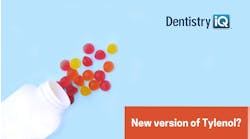The Organization for Safety, Asepsis and Prevention (OSAP) and the DentaQuest Partnership for Oral Health Advancement have joined forces to compile a set of best practices for dental professionals as they return to their practices with COVID-19 still an issue. A group of national experts on infection prevention produced a set of guidelines—Best Practices for Infection Control in Dental Clinics During the COVID-19 Pandemic—to help dentists and dental team members steer through the unknowns during this unprecedented time.
The guide has organized checklists and easy-to-implement processes, arranged in a way that simplifies confusion. In addition to current infection control regulations and recommendations, this resource guide covers:
- Preparation of entryway and lobby areas
- Preparation and screening of the dental team
- Guidance for patients’ arrival at appointments
- Specifics for patient care in the dental operatory
- Necessary adjustments in clinical areas
Designed for dental clinicians and other dental staff, the best practices included in the resource guide are the culmination of expert advice from groups such as the Centers for Disease Control and Prevention (CDC), the Occupational Safety and Health Administration (OSHA), the American Dental Association (ADA), and the American Dental Hygienists’ Association (ADHA), to name a few. The hope is that this guide will help you return to work protected so that you can resume providing needed dental care for your patients in a safe environment. Updates to the resource will be made as national guidelines change.
We spoke with Julie Hawley, PhD, CAE, the director of analytics and evaluation at the DentaQuest Partnership for Oral Health Advancement, where she works with the team to transform data into knowledge that can be used to raise awareness of oral health in a big-picture way. In her current capacity, she is DentaQuest’s liaison who works directly with OSAP.
DIQ: How did the partnership between DentaQuest and OSAP come about?
DIQ: What is the most important thing you hope dental professionals can gain from this new resource?
Hawley: The Best Practices for Infection Control in Dental Clinics During the COVID-19 Pandemic is a curation of evolving guidance from the CDC, OSHA, ADA, and ADHA. Following this guidance is critical to providing the safest possible dental care during the pandemic, and we hope that having all of this information in one resource will help providers implement the guidance and feel more comfortable about the care they provide.
This virus is new to the world, and scientists are learning more and more every day. It stands to reason that this knowledge can and should change the way we provide dental care as we learn more and adapt. Because of this, it is important to know that this document is a living resource, meaning that it will be continually updated as guidance evolves from the agencies mentioned above.
Additionally, OSAP and the DentaQuest Partnership expect to release a new resource for the general public in mid-July so patients can better understand how dentistry is preparing for safe care during the pandemic, know what questions to ask, and be more comfortable about the care that they receive.
DIQ: We wanted to find out exactly what this type of resource means in the life of a practicing dentist, so we checked in with Stacey L. Gividen, DDS, editorial co-director of our new Chairside Daily newsletter.
DIQ: How do you think these resources from DentaQuest and OSAP can help you in your practice?
DIQ: What is the most pressing concern you have regarding practicing dentistry during the COVID-19 pandemic?
Dr. Gividen: Reassuring staff and patients that all will be OK. Let’s be realistic—the public media and various social media platforms have not been helpful as they have given rise and fed into the frenzy of this pandemic. And this has had a trickle-down effect into the dental profession. What I’ve found is that safety, the perception of safety, and practicing what I was already doing prior to the pandemic is at the forefront of my day-to-day patient encounters. Keeping a level head, not feeding into the rhetoric, and focusing on what my specific patient and practice needs are has been helpful with respect to my dental office and all its workings.
DIQ: Do you have a word of advice to share with your dental colleagues?
Dr. Gividen: If you really and truly think about it, we already know what to do. The disruption in our status quo has no doubt ruffled our feathers, but once the dust has settled, I’ll submit that we are already fairly compliant with what needs to be done to keep ourselves, our staff, and our patients safe—with a few modifications of course. COVID-19 isn’t going anywhere—that’s a fact. Here’s what else I know: the need for our profession and professional services isn’t going anywhere either. So, we have to modify, adapt, and overcome. COVID-19 be damned—we’re here to stay. And that, my friends, is my unfiltered take on it!
Helpful resources:
- OSAP/DQP Best Practices for Infection Control in Dental Clinics During the COVID-19 Pandemic
- Guidance for Dental Settings: Interim Infection Prevention and Control Guidance for Dental Settings During the COVID-19 Response (updated 6/17/20)
Julie Hawley, PhD, CAE, received her PhD from Harvard University’s Biological and Biomedical Sciences Program and completed a postdoctoral fellowship at the University of California, San Francisco. She is an executive scholar of the Nonprofit Management Program at Northwestern University’s Kellogg School of Management and is a Certified Association Executive. She is also a fellow of the NIH Training Institute for Dissemination and Implementation Research in Health and a fellow of the Alan Alda Center for Communicating Science. She has extensive experience in evidence-based health care, medical/dental research and analytics, implementation science, scientific publishing, association leadership, and advocacy.
Stacey L. Gividen, DDS, a graduate of Marquette University School of Dentistry, is in private practice in Hamilton, Montana. She is a guest lecturer at the University of Montana in the Anatomy and Physiology Department. Dr. Gividen has been the editorial director of Endeavor Business Media’s clinical dental specialties e-newsletter, Breakthrough Clinical, and is now transitioning to her new role as editorial co-director of Chairside Daily. She is a contributing author for DentistryIQ, Perio-Implant Advisory, and Dental Economics and serves on the Dental Economics editorial advisory board. You may contact her at [email protected].








